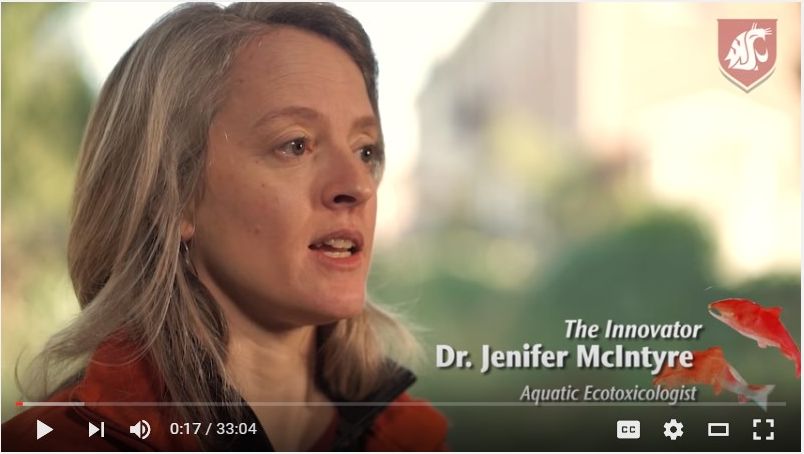Think and Act like a Watershed: Rain gardens can help save salmon
Note to Reader:
In 1996, Richard Horner and Chris May (University of Washington) published their seminal research on the cumulative impacts of land use change on stream health. Their findings shook conventional stormwater management wisdom in the Pacific Northwest to its very foundation.
The significance of their research findings was in gaining recognition of the primacy of hydrology. Get that right and both stream restoration and residential water quality typically follow along.
Twenty years later, new research by Dr. Jenifer McIntyre (aquatic ecotoxicologist, Washington State University) demonstrates the dual benefits of rain gardens when they mimic the natural Water Balance and eliminate toxicity from urban runoff.

CLICK TO WATCH YOUTUBE VIDEO: https://www.youtube.com/watch?v=BNruLbD2sP8
Dr. Jenifer McIntyre, aquatic ecotoxicologist, explains the science at a WSU Innovators Lecture titled: “Stormwater detox: How natural infrastructure can help save salmon” (April 2016).
The presentation is detailed in providing an understanding of why rain gardens eliminate toxicity.
Think and Act like a Watershed: A journey to a water-resilient future starts with the first rain garden (3rd in a series connecting past and present research)
Coho Salmon – “canary in the coal mine”
Coho salmon spend half their lives in freshwater. This makes them sentinels whose health speaks well for the food web, the quality of its streams, and the rainwater runoff that does or does not flow into them. More than a decade ago, unintended consequences for a City of Seattle stream restoration project in Longfellow Creek led to discovery of a phenomenon called Pre-Spawn Mortality (PSM) which is caused by road runoff.
“The City of Seattle built it (stream restoration), the coho salmon came, the salmon died. Subsequent research resulted in discovery of PSM,” recalls Chris May, Surface & Stormwater Division Director with Kitsap County Public Works. Previously he was Urban Watershed Manager with Seattle Public Utilities. “PSM is a phenomenon where more than 60% of adult coho salmon die before they get a  chance to spawn. This has been observed across much of the Puget Sound region.”
chance to spawn. This has been observed across much of the Puget Sound region.”
“Research has been in progress for more than a decade. Jenifer McIntyre has extended the research by taking highway runoff and demonstrating that rain gardens eliminate toxicity. This dual benefit rounds out the case for retrofitting rain gardens to mimic the natural Water Balance. Water quality is not the culprit until a watershed is well up the development scale. Physical impacts of a changing landscape is THE issue. Then riparian, in-stream and water quality – in that order,” emphasizes Chris May.
Rain Gardens Eliminate Toxicity
“At Washington State University, I study urban stormwater runoff and its impacts on aquatic animals. The really exciting thing about the research that we are doing, and the results we are getting, is that it gives people hope. Green stormwater infrastructure really can be part of the solution,” states Jenifer McIntyre, an Aquatic Ecotoxicologist with the Washington Stormwater Center. Her Ph.D. research in 2010 at the University of Washington helped pass legislation in Washington and California that phases out copper and other metals in brake pads.
 “Five years ago when we started our research, we chose to work with road runoff because roads are the common denominator across all urban land uses. It turns out that road runoff can cause mortality in juvenile and adult salmon, and heart defects in developing fish. We also wanted to know whether toxic effects could be prevented. One of the potential solutions is green stormwater infrastructure, such as rain gardens, to soak the water into the soil and filter out contaminants.”
“Five years ago when we started our research, we chose to work with road runoff because roads are the common denominator across all urban land uses. It turns out that road runoff can cause mortality in juvenile and adult salmon, and heart defects in developing fish. We also wanted to know whether toxic effects could be prevented. One of the potential solutions is green stormwater infrastructure, such as rain gardens, to soak the water into the soil and filter out contaminants.”
“We don’t need to know everything about how toxic runoff is, or how it causes toxicity, to be able to do something about the problem. To date, the experimental results are pretty impressive – for example, 100% fish dead in polluted runoff compared with 100% fish survival in the same water after it had been filtered.”
A Path Forward
“One of the new results I am most excited about is the cause-of-death research. For more than a decade we have been studying pre-spawn mortality in coho returning to urban areas. For the first time, we have a real path forward for figuring out what about urban runoff is causing the problem.”
“The cause-of-death research has shown that, based on blood gas and blood chemistry, coho exposed to urban runoff appear to suffer from a lack of oxygen at the tissue level.”
“We know there is oxygen in the water, and oxygen is in the fish’s blood, but that oxygen either isn’t getting to their tissues or their tissues aren’t able to use it. With this new information, we can start tracking down the precise mechanism causing the hypoxia, which we hope will help us identify the responsible contaminants,” concludes Jenifer McIntyre.
Upcoming in the “Ecosystem-based Understanding Series”
This is a 4-part series. In Part 1, we introduced new ecosystem-based adaptation (EbA) research in BC that may inspire a new generation to “think and act like a watershed”. In Part 2, we celebrated the 20th anniversary of publication of the seminal research by Richard Horner and Chris May. In Part 4, we conclude with the parallel journeys of Washington State and British Columbia and how the Water Balance Methodology is the foundation for an ecosystem-based approach to protection of hydrologic integrity, and hence creek system resilience.
To Learn More:
The results of the research were published in the August 2015 issue of the Science Direct Journal, the world’s leading source for scientific, technical, and medical research. Download Soil bioretention protects juvenile salmon and their prey from the toxic impacts of urban stormwater runoff. The article is published under a Creative Commons license.

